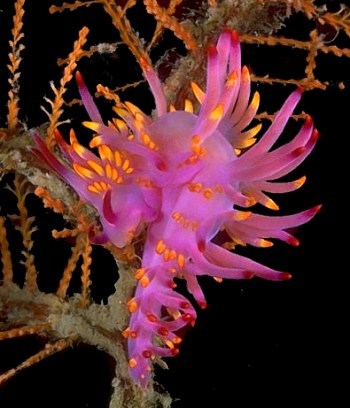
Cuthona sibogae
(Bergh, 1905)
Order: NUDIBRANCHIA
Suborder: AEOLIDINA
Family: Tergipedidae
DISTRIBUTION
Probably widespread Indo-West Pacific.
PHOTO
UPPER RIGHT: on food hydroid Sertularella. Darwin, Northern Territory, June 1987. AM C153594. Photo: Bill Rudman.
LOWER: Scanning electron micrographs of the radula of an animal from Broadhurst Reef, off Townsville, North Queensland. Scale bar = 10 microns. Photo: Geoff Avern.
A moderately large aeolid nudibranch in which the cerata are arranged in about eight fan-like clusters on each side of the body. The cerata are cylindrical, tapering at the tip to a rounded point. The general body colouration is pale lilac purple. The oral tentacles and the upper half of the slender smooth rhinophores are a reddish purple. The cerata are similar in colour to the body except for a bright golden yellow tip and a band just below the yellow tip which ranges from deep reddish purple to deep purple. Many of the smaller outer cerata in each row are golden yellow with nno purplish basal region. It grows to 35mm in length. It is usually found associated with its food, an orange hydroid, Sertularella quadridens.
Previously called Cuthona sp. 4 in the Forum. See messages below.
Reference:
• Bergh, L.S.R. (1905). Die Opisthobranchiata. Siboga Expeditie Report, 50: 248pp., Pls 1-20.
• • Marshall, J.G. & Willan, R.C. (1999). Nudibranchs of Heron Island, Great Barrier Reef. A survey of the Opisthobranchia (Sea Slugs) of Heron and Wistari Reefs. Backhuys Publishers, Leiden, pp. 1-257, figs 1-280
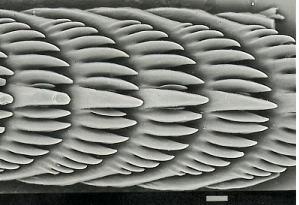
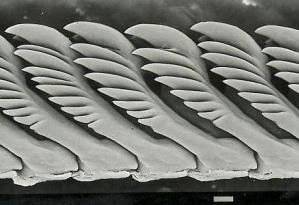
Rudman, W.B., 2003 (October 20) Cuthona sibogae (Bergh, 1905). [In] Sea Slug Forum. Australian Museum, Sydney. Available from http://www.seaslugforum.net/find/cuthsp4
Related messages
Cuthona sibogae from Indian Ocean (Mayotte Island)
March 18, 2009
From: Sandrine et Hugues Flodrops

Concerning message #1529:
Dear Bill,
Here is an aeolid which we think is Cuthona sibogae. Can you explain what are the differences between Cuthona and Flabellina. Thanks again for your forum.
Locality: Boulevard des Platax (Passe en S), 19 metres, Mayotte Island, Indian Ocean, 2 March 2009, PM. Length: 25 mm. Photographer: Hugues Flodrops.
Regards.
Sandrine et Hugues
hugues.flodrops@wanadoo.fr
Flodrops,H., 2009 (Mar 18) Cuthona sibogae from Indian Ocean (Mayotte Island). [Message in] Sea Slug Forum. Australian Museum, Sydney. Available from http://www.seaslugforum.net/find/22317
Dear Sandrine and Hugues,
Yes this does appear to be Cuthona sibogae, which from records on the Forum has a wide distribution on both the Indian and western Pacific Oceans. Aeolids are quite difficult to identify - even to family - from their external characters. We used to think that the arrangement of the cerata in vertical rows and arches etc could be used, but we now know that such characters have evolved more than once in different phylogenetic groups. The genus Flabellina is a good example, with species showing quite different ceratal arrangements. I am afraid a good look at the internal anatomy is usually required to be sure. In this case the radula ribbon of species of Cuthona consist of a many rows, each containing just a single median tooth. In species of Flabellina there is usually a tooth on each side of the central tooth, and in some species there are three to five flanking teeth.
Best wishes,
Bill Rudman
Cuthona sibogae from Thailand, feeding
February 10, 2009
From: Marcel Tanke


Concerning message #3034:
Dear Bill,
For the record, here a couple of pictures of Cuthona sibogae feeding on its favourite orange hydroid. The second picture shows 3 animals.
Is Cuthona sibogae the same as Trinchesia sibogae?
Locality: Island Ko Ha One, 20 m, Thailand, Andaman Sea, 25 January 2009. Length: 2 cm. Photographer: Marcel Tanke.
Best regards,
Marcel
marceltanke@cs.com
Tanke, M.A., 2009 (Feb 10) Cuthona sibogae from Thailand, feeding. [Message in] Sea Slug Forum. Australian Museum, Sydney. Available from http://www.seaslugforum.net/find/22217
Thanks Marcel,
This species shows a remarkable consistency in its choice of food hydroid. It's good to get another record. Concerning my unwillingness to replace Cuthona with Trinchesia see my earlier comments [message #21285] .
Best wishes,
Bill Rudman
Egg-laying Cuthona sibogae from Port Stephens
August 6, 2008
From: Leanne & David Atkinson

Dear Bill,
We found these eggs on a colony of the orange hydroid Sertularella quadridens, which had lots of Cuthona sibogae in it. We have never seen another nudibranch in this hydroid and these look like nudibranch eggs. We know you can't make a positive identification unless you actually see them laying the eggs but it would seem that these may be their eggs. Their eggs aren't mentioned in the fact sheet and there doesn't seem to be any other messages re their eggs. Have Cuthona sibogae eggs been observed before? We'll keep trying to catch them in the act of laying.
Locality: Fly Point, Port Stephens - Great Lakes Marine Park, Port Stephens, 12 metres, New South Wales, Australia, Pacific, 24 May 2008, Scattered sponges, hydroids, ascidians and soft corals on a sandy bottom. Length: Approximately 30 mm. Photographer: Leanne & David Atkinson.
Best wishes,
Leanne & David Atkinson
atk@hunterlink.net.au



Dear Leanne & David,
Thanks for the photos of the egg masses. You are right to be cautious, but I tend to agree with your strong suspicions that these are the eggs of Cuthona sibogae. I added a close-uup alongside showing a section of the hydroiod to show the fully extended polyps on which this aeolid feeds. In this species the polyps each have their own case [theca] into which the polyp can withdraw. Some hydroids, like Tubularia and its relatives don't have such cases and are known as athecate hydroids. In identifying thecate hydroids, obvious characters such as whether the stalks branch or not, and the nature of the branching, are used, but also the arrangement of the individual theca - are they arrangement opposite each other along each branch, or are they arranged alternately etc, etc. That's why it is very difficult for an expert to identify hydroid species from photos, unless the close-ups show the stalks and the thecae very clearly. Even with such photos, I am afraid hydroid specialists are not that common.
Best wishes,
Bill Rudman
Mating Cuthona sibogae
August 5, 2008
From: Leanne & David Atkinson

Dear Bill,
There are quite a few Cuthona sibogae around at the moment at Fly Point. Here are some mating photos on their food hydroid Sertularella quadridens.
Locality: Fly Point, Port Stephens - Great Lakes Marine Park, Port Stephens, 12 metres, New South Wales Australia, Pacific, 06 July 2008, Scattered sponges, hydroids, ascidians and soft corals on a sandy bottom. Length: Approximately 30 mm. Photographer: Leanne & David Atkinson.
Leanne & David Atkinson
atk@hunterlink.net.au
Atkinson, L. & D., 2008 (Aug 5) Mating Cuthona sibogae. [Message in] Sea Slug Forum. Australian Museum, Sydney. Available from http://www.seaslugforum.net/find/21760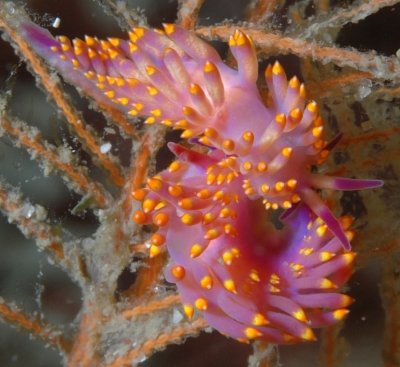
Dear Leanne & David,
This species certainly has a close attachement to this species of hydroid. I guess it is useful that the orange branches of this hydroid make it so easily identifiable
Best wishes,
Bill Rudman
Mating Cuthona sibogae
August 28, 2007
From: Patricia Dilworth

Dear Bill,
In May, 2007 on a dive trip aboard the Na'ia in Fiji, we found this pair of Cuthona sibogae mating. It is fun to happen upon something happening!
Dive was at Grand Central Station dive siteat about 70 ft depth.
Locality: Ocean dive from Na'ia, 70 ft., Fiji, Pacific, 2 May 2007, Ocean dive. Length: unknown. Photographer: Patty Dilworth.
Patty Dilworth
padilworth@aol.com
Dilworth, P., 2007 (Aug 28) Mating Cuthona sibogae. [Message in] Sea Slug Forum. Australian Museum, Sydney. Available from http://www.seaslugforum.net/find/20560Thanks Patty,
Best wishes,
Bill Rudman
Cuthona sibogae from Sulawesi
April 18, 2007
From: Mike Krampf

Here is a picture of a Cuthona sibogae that was taken at Bom Rock dive site off Biaro Island which is near Sulawesi. Hope this helps on the geographic distribution of this species.
Locality: Dive Site - Bom Rock, 55 ft, Biaro Island, Indonesia, Celebes Sea, 25 October 2006, Pinnacle. Length: 10 mm. Photographer: Mike Krampf.
Mike
mtkrampf@yahoo.com
Krampf, M., 2007 (Apr 18) Cuthona sibogae from Sulawesi. [Message in] Sea Slug Forum. Australian Museum, Sydney. Available from http://www.seaslugforum.net/find/18627Thanks Mike,
Bill Rudman
Unidentified nudibranch from Mabul
March 3, 2006
From: David Kearnes

Could I please get help identifying this nudibranch, which was photographed by Doug Perrine at Kapalai, off Borneo in the Celebes Sea.
Locality: Kapalai, 30 ft, Borneo, Celebes Sea. Length: 3/4 inch. Photographer: Doug Perrine.
diverdave@verizon.net
Kearnes, D., 2006 (Mar 3) Unidentified nudibranch from Mabul . [Message in] Sea Slug Forum. Australian Museum, Sydney. Available from http://www.seaslugforum.net/find/15882Dear David and Doug,
Your photo seen here is what we have referred as Cuthona sibogae. Originally placed in the genus Hervia by Bergh, this species has become the subject of some systematic bantering. Just as boys will be boys, taxonomists will be taxonomists, and not always agree with one another.
In a recent paper by Miller and Willan (2005), propose that C. sibogae shares more characters with the long defunct genus Trinchesia and proposed the re-establishment of Trinchesia as a distinct genus. There exists a long trail of papers switching the genus from Cuthona to Trinchesia and back. Most taxonomists today favor Cuthona. With this newest paper I am sure we can expect more banter to follow, jerking this beautiful species from one name to another.
- Miller, M. C. & R. C. Willan. 2005. A redescription and taxonomic reappraisal of the Indo-Pacific aeolid nudibranch Trinchesia sibogae (Bergh, 1905)(Gastropoda, Opisthobranchia). Vita Malacologia. 3: 69-75.
Best wishes,
Dave Behrens
Are Phestilla sibogae & Cuthona sibogae different?
August 17, 2005
From: Xikun Song
What are the differences between Phestilla sibogae and Cuthona sibogae? Are they the same species?
Thanks!
Xikun Song
xksong@yanan.xmu.eud.cn
Song, X.K., 2005 (Aug 17) Are Phestilla sibogae & Cuthona sibogae different?. [Message in] Sea Slug Forum. Australian Museum, Sydney. Available from http://www.seaslugforum.net/find/14133Dear Song,
Phestilla sibogae is a synonym for the coral-eating species Phestilla lugubris while as you will see on the Forum Cuthona sibogae is a brightly coloured hydroid feeder. Bergh named quite a few nudibranchs 'sibogae' after the Siboga Expedition, a Dutch scientific voyage of discovery mainly to Indonesia at the end of the 1800s and beginning of the 1900s. There is a short informative account at http://www.science.uva.nl/library/MaxWeber/Siboga.htm
Best wishes,
Bill Rudman
Cuthona sibogae on the Sunshine Coast
October 20, 2003
From: Gary Cobb

Hi Bill!
I had a great Saturday at Old Woman Is off Mooloolaba Sunshine Coast Audtralia. Found a few you might be interested in. Here is one...
Found what I believe is Cuthona sibogae.
Location: Old Woman Is, Mooloolaba, Sunshine Coast, Southern Queensland, Australia
Site: The Wall
Depth: 9m
Length; 10mm
Date: 20-9-03
Day time
Many thanks,
Gary Cobb
gary@cobb.com.au
Cobb, G., 2003 (Oct 20) Cuthona sibogae on the Sunshine Coast. [Message in] Sea Slug Forum. Australian Museum, Sydney. Available from http://www.seaslugforum.net/find/11006Dear Gary,
It's Cuthona sibogae
Bill Rudman
Cuthona sibogae - diseased?
September 3, 2003
From: Leanne & David Atkinson


Dear Bill,
Can you explain this phenomena? During May we watched the only Cuthona sibogae on a patch of orange hydroid at Fly Point. Early in June, the last time we saw it, it had white spots on the cerata. Is this a sign of age, illness or something else entirely? Are these little bubbles forming as discussed early on the forum with some laboratory animals with cerata? Can you help?
Upper Photo 1 & 2:
Location: Fly Point, Marine Reserve, Port Stephens, New South Wales, Australia. Tide: high. Depth: 12m. Water Temp: 19 degrees c.
Upper Photo: 24 May 2003
Lower Photo: of 'spotted animal' 7 June 2003.
Thanks,
Leanne & David Atkinson
atk@hunterlink.net.au

Dear Leanne & David,
I don't think this spotting is the same thing as the bubbles in Hermissenda which apparently form insode the cerata and cause it to float. I suspect if I had seen your spotted animal I would have thought it was a strange colour variation, but your observations suggest that it either diseased or old age is causing something strange to occur. I am afraid I have no idea what is happening. I have included alongside close-ups of the hydroid [Sertularella sp.] your animal was on. The upper photo is from May and the lower, from June. My first thought was that perhaps your animal was starving, but from the abundance of polyps in the bottom photo, your animal was certainly not short of available food.
Best wishes,
Bill Rudman
Cuthona sibogae from Port Stephens
February 7, 2003
From: David & Leanne Atkinson
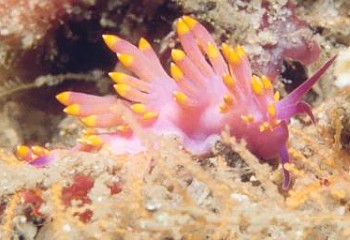
Hi Bill,
It has been a pretty good summer for nudis this year. Last summer was very bad. Even the normally common ones were few and far between. Any ideas on that one?
Here is a few nudi we can't identify. Can you help? It came from Port Stephens, [New South Wales, eastern Australia].
David & Leanne Atkinson
atk@hunterlink.net.au
Atkinson, D. & Atkinson, L., 2003 (Feb 7) Cuthona sibogae from Port Stephens. [Message in] Sea Slug Forum. Australian Museum, Sydney. Available from http://www.seaslugforum.net/find/9120Dear David & Leanne,
This is Cuthona sibogae, a tropical visitor to the New South Wales coast, but certainly a more regular visitor than some species.
Concerning last year being a bad year. Much of the interesting Port Stephens' fauna are the tropical visitors. Unless conditions are right, the larvae will be unable to successfully move down the eastern Austalian coast and into the large bay we call Port Stephens. And to make it even more difficult, the sea slugs' special food items will have also needed to make the journey. On top of all that, conditions in Port Stephens need to be good as well, and we all know that even the best places can sometimes have bad years. Bays and inlets in particular are prone to rapidly changing physical conditions. I can't recall any particular event which could have affected Port Stephens last year, but I am not surprised that now and then bad years occur.
Cheers
Bill Rudman.
Cuthona sibogae from Riau, Indonesia
November 4, 2002
From: Alice Lee

Here are some photos of Cuthona sibogae feeding and mating.
Riau Archipelago, Indonesia
Depth: 10m
Size: < 10cm
Date: 26 October 2002
Regards,
Alice
alee@dlink.com.sg


Thanks Alice,
Bill Rudman
Cuthona sibogae? from eastern Australia
October 29, 2002
From: David Harasti


Hi Bill,
This animal was found in mid July 2001 on the Agnes Irving shipwreck located off South West Rocks on the North Coast of New South Wales - Australia. The depth was 10 metres and the water temp was about 20 degrees. I have just looked through the new Neville Coleman book (great book!) and I think it could be Cuthona sibogae. Do you think this the correct ID?
Thanks in advance,
David Harasti
diving@webone.com.au
Harasti, D., 2002 (Oct 29) Cuthona sibogae? from eastern Australia. [Message in] Sea Slug Forum. Australian Museum, Sydney. Available from http://www.seaslugforum.net/find/4903Dear David,
Yes this is Cuthona sibogae. It always seems to be on this orange hydroid, so that is another useful identifying character.
Best wishes,
Bill Rudman.
Re: Flabellina? from the Red Sea
October 26, 2002
From: Erwin Koehler
Hi Bill,
Dave Behrens IDed this slug as Cuthona sibogae.
Erwin
erwin@medslugs.de
Koehler, E., 2002 (Oct 26) Re: Flabellina? from the Red Sea. [Message in] Sea Slug Forum. Australian Museum, Sydney. Available from http://www.seaslugforum.net/find/8263Thanks Erwin,
Dave Behrens could well be right. Certainly if the typical purple colour of C. sibogae removed this could easily be that species. Without being able to see the rhinophores, or the front of the foot, clearly any identification is a bit problematic.
Cheers,
Bill Rudman
Re: Flabellina? from the Red Sea
October 26, 2002
From: Philip Cromwell
Bill,
I'm still learning this stuff, but is there a reason you think this aeolid is not a color form of Cuthona sibogae, or related species? I realize the Red Sea is a long ways from the South Pacific, but it looks like C. sibogae has quite a large distribution.
Thanks,
Phil
chiron42@msn.com
Cromwell, P., 2002 (Oct 26) Re: Flabellina? from the Red Sea. [Message in] Sea Slug Forum. Australian Museum, Sydney. Available from http://www.seaslugforum.net/find/8281Dear Phil,
No reason at all. In fact Erwin has just sent a message saying Dave Behrens has had the same idea.
Cheers,
Bill Rudman
Flabellina? from the Red Sea
October 24, 2002
From: Erwin Koehler

Dear Bill,
This one is from the Red Sea, Egypt, Sha'ab Mansour, size about 3 cm, depth 20 m, Sept. 30, 1999. It was taken by Jim Anderson [JAnder4454@aol.com]
Erwin Koehler
Erwin@medslugs.de
Koehler, E., 2002 (Oct 24) Flabellina? from the Red Sea. [Message in] Sea Slug Forum. Australian Museum, Sydney. Available from http://www.seaslugforum.net/find/4074Dear Erwin,
It looks like a species of Flabellina and possibly F. exoptata, but I can't see enough detail in the rhinophores to be sure. Both the rhinophores and the oral tentacles appear to be a uniform purple, which is not the usual colour for F. exoptata.
Best wishes,
Bill Rudman
Cuthona sibogae from Papua New Guinea
October 23, 2002
From: Erwin Koehler

Dear Bill
Attached is a photo from Papua New Guinea taken by Beate and Peter Lange [beate.lange@aon.at] - other data was not recorded. Is it Cuthona sibogae or something else?
Erwin
Erwin@medslugs.de
Koehler, E., 2002 (Oct 23) Cuthona sibogae from Papua New Guinea. [Message in] Sea Slug Forum. Australian Museum, Sydney. Available from http://www.seaslugforum.net/find/4066Dear Erwin,
It's Cuthona sibogae
Cheers,
Bill Rudman
Flabellina? identification
March 26, 2002
From: Alice Lee

I have recently seen this nudibranch but do not know whether it is Flabellina species or others, can someone help me to identify it please.
Thanks.
Alice Lee
alee@dlink.com.sg
Lee, A., 2002 (Mar 26) Flabellina? identification. [Message in] Sea Slug Forum. Australian Museum, Sydney. Available from http://www.seaslugforum.net/find/6499Dear Alice,
Could you let me know where it is from please? I guess it may be Singapore, from your email address. Although it does look like a species of Flabellina I am pretty sure that your animal is Cuthona sibogae which appears to feed exclusively on an orange hydroid. I think in your photo only the basal stalk of its food remains.
Best wishes,
Bill Rudman
Cuthona sibogae from Port Stephens
March 18, 2002
From: Akos Lumnitzer
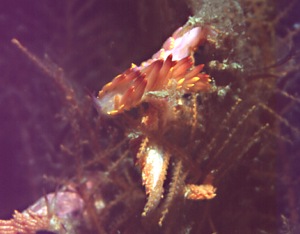

Hi Bill,
My wife and I were up at Nelson Bay [Port Stephens, New South Wales, Australia] recently and have seen these Flabellinids everywhere on the hydroid colonies. Could they be another color variation of good, old Flabellina rubrolineata?
The depth of sightings varied, but the nudies were around 15-25mm in length.
Kind regards
Ákos
Akos.Lumnitzer@exel.com
Lumnitzer, A., 2002 (Mar 18) Cuthona sibogae from Port Stephens. [Message in] Sea Slug Forum. Australian Museum, Sydney. Available from http://www.seaslugforum.net/find/6413Dear Ákos,
This animal looks quite like F. rubrolineata but is in fact Cuthona sibogae which apparently feeds only on this orange-yellow hydroid colony of the genus Sertularella.
Best wishes,
Bill Rudman
Cuthona sibogae from the Marshall Islands
June 18, 2001
From: Scott Johnson

Hi Bill,
Here is an eolid I have found in several atolls in the Marshall Islands. I'd identified it as a Cuthona based on the radula (an admittedly very rough sketch is attached). Thanks to the Forum, I think I can now assume it is C. sibogae, even though it lacks the red cerata band below the yellow. The Marshalls specimens are around 10mm or less, and occasionally aggregate on their hydroid prey, which looks like the same one it eats in your area. Both photos were taken at Enewetak Atoll at a depth of about 8 meters, in the shadow of a World War II era concrete barge run up on a reef.
Scott
johnson@kmr.ll.mit.edu


Thanks Scott,
Bill Rudman.
Cuthona sibogae from Mozambique
June 11, 2001
From: Kirsty Miller

Dear Bill
I found these nudibranch on a coral reef depth 21 m at Ponta Malongane in Southern Mozambique. Size is 2 cm. I think it could be of the family Flabellinidae. Please help me with an ID
Thanks
Kirsty Miller
divegirl@xsinet.co.za
Miller, K., 2001 (Jun 11) Cuthona sibogae from Mozambique. [Message in] Sea Slug Forum. Australian Museum, Sydney. Available from http://www.seaslugforum.net/find/4500Dear Kirsty,
I think this is Cuthona sibogae but I would need to look at its anatomy to confirm it. It is probably the same as Valda Fraser's animal from South Africa.
The secondary branch on the left oral tentacle is obviously a developmental abnormality.
Best wishes,
Bill Rudman
Food of Cuthona sibogae
September 17, 2000
From: Richard Willan
Bill,
During her recent visit here, Jan Watson identified the golden hydroid that is the food of Cuthona sibogae as Sertularella diaphana. That aeolid is common in both Darwin Harbour and southern Queensland, and this hydroid is the only one I have ever found it on in both places.
Cheers,
Richard.
Richard.Willan@nt.gov.au
Willan, R., 2000 (Sep 17) Food of Cuthona sibogae. [Message in] Sea Slug Forum. Australian Museum, Sydney. Available from http://www.seaslugforum.net/find/3034Thanks Richard,
Bill Rudman.
Re: aeolid from Fiji
September 15, 2000
From: Bruce Wight
Dear Bill,
Mike Miller told me that the nudibranch I found in Fiji, your Cuthona sp. 4, is Cuthona sibogae. See his page on the species at http://siolibrary.ucsd.edu/slugsite/phil/sibogae.html .
Bruce Wight
bwproductions@earthlink.net
Wight, B., 2000 (Sep 15) Re: aeolid from Fiji. [Message in] Sea Slug Forum. Australian Museum, Sydney. Available from http://www.seaslugforum.net/find/3020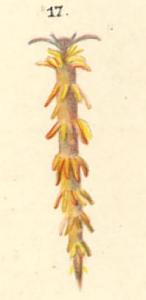
Dear Bruce,
Thanks for your message. I have also had an email from Richard Willan referring me to Marshall & Willan (1999) where it also identified as Cuthona sibogae. It is ironic that I have previously identified it as Cuthona sibogae in a calendar I produced in 1989, and in Mollusca, the Southern Synthesis in 1998. Although some visitors to the Forum think at times I am not cautious enough with my identifications, for some reason I decided to be very cautious when I added this species to the Forum.
I am happy however to throw caution to the winds and identify Cuthona sp. 4 as Cuthona sibogae but before I do has anyone any objections? I have included here a scan of the published painting of Hervia sibogae Bergh, 1905 [Plate 2, fig 17]. The colour and shape of the animal in the painting is similar to the photos on the Forum, and the radula is also similar to Bergh's description. I have added a couple of photos of the radula of Cuthona sp. 4 to the top of the page. It is one of the most beautifully shaped radular teeth I have seen.
Interestingly Marshall & Willan (1999) note this species is only found on the hydroid Sertularella, which is the hydroid I have photographed it on at the top of the page.
Best wishes,
Bill Rudman.
aeolid from Fiji
September 13, 2000
From: Bruce Wight


Hi Guys,
Can you help me identify this branch. Can't find it in any of our books, some kind of Flabellina maybe? My wife found it in Fiji in about 60 feet of water on the reef.
Thanks,
Bruce Wight
bwproductions@earthlink.net
Wight, B., 2000 (Sep 13) aeolid from Fiji. [Message in] Sea Slug Forum. Australian Museum, Sydney. Available from http://www.seaslugforum.net/find/3012Dear Bruce,
It looks quite like a Flabellina but it is in fact a species of Cuthona, which I am calling at present Cuthona sp. 4.
Best wishes,
Bill Rudman.
Cuthona? from Sth Africa
December 13, 1999
From: Valda Fraser
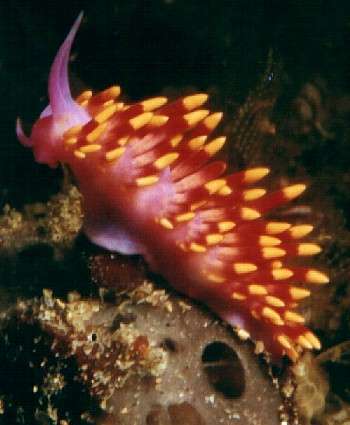
Dear Bill,
Here is a red/yellow aeolid. Any ideas?
Locality: South Coast of Kwa Zulu Natal, South Africa, near Port Shepstone. Rocky reef
Depth: 20-25m. October 1999. Size: 25mm.
Valda Fraser.
iti04937@mweb.co.za
Fraser, V., 1999 (Dec 13) Cuthona? from Sth Africa. [Message in] Sea Slug Forum. Australian Museum, Sydney. Available from http://www.seaslugforum.net/find/1529Dear Valda,
There are a number of 'unknown' red or purple aeolids with yellow bands on the cerata. At least one is a Flabellina and another a Cuthona. I think this is a cuthonid but without looking at its anatomy, I say that with some hesitation.
It looks quite like Gosliner's Cuthona sp. 3 (1987: p.118, and is probably the same as Cuthona sp. 4. which I illustrate above from Darwin, Australia.
Bill Rudman.
Rudman, W.B., 1999 (Dec 13). Comment on Cuthona? from Sth Africa by Valda Fraser. [Message in] Sea Slug Forum. Australian Museum, Sydney. Available from http://www.seaslugforum.net/find/1529Cuthona from Port Stephens, New South Wales
December 13, 1999
From: Ron Greer

Dr Rudman,
I shot the attached image about 8 years ago on a night dive at Halifax Park in Port Stephens NSW.
No others were seen, the depth was about 12 metres and the size was about 15mm long. They appear to be a colour/form variation of Flabellina rubrolineata. Could you please confirm or deny my identification.
Regards,
Ron Greer
diveimage@i-o.net.au
Greer, R., 1999 (Dec 13) Cuthona from Port Stephens, New South Wales. [Message in] Sea Slug Forum. Australian Museum, Sydney. Available from http://www.seaslugforum.net/find/1659Dear Ron,
It looks a bit like a Flabellina but I am pretty sure it is the species of Cuthona which for want of a better name I am calling Cuthona sp. 4.
There are a number of similarly coloured species already reported from the tropical Indo-West Pacific but until their identities are sorted out there is no point in introducing new names.
Best wishes,
Bill Rudman.
